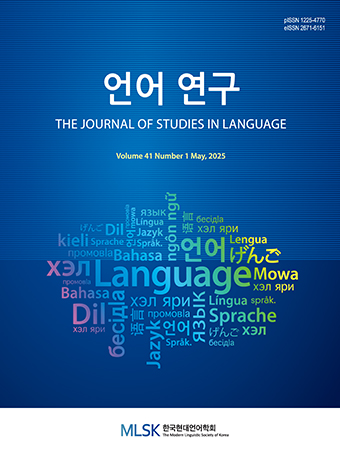Abstract
References
Information
This paper claims that sluicing constructions in Korean do not involve sluicing contra Takahashi (1993, 1994). It will furthermore be demonstrated that sluicing constructions are not cleft constructions (Nishiyama, Whitman, and Yi 1996, and Park 2001 among others), using the diagnoses by Merchant (2001). It will be demonstrated that the two major arguments of the cleft approach for Korean sluicing constructions, namely, ‘parallels in case’ and ‘optional copula’ cannot be arguments for the cleft approach, which just follows from the present proposal of the non-elliptical wh-question for Korean sluicing constructions. It will also be demonstrated that the present proposal sufficiently deals with postposition stranding in Korean sluicing constructions for which the cleft approach fails. The current proposal has a nontrivial implication on the typology of sluicing constructions across languages: non-elliptical wh-question in addition to sluicing and cleft.
- Choi, YoungSik. 2002. Asymmetry of Scope Taking in Wh-Questions. Doctoral Dissertation, University of Southern California, Los Angeles, CA.
- Choi, YoungSik. 2003. Intervention Effect in Korean Wh-Questions Revisited. Paper Presented at Glow in Asia 4, Seoul National University.
- Choi, YoungSik. 2007. Intervention Effect in Korean Wh-questions: Indefinite and Beyond. Lingua 117, 2055-2076.
- Choi, YoungSik. 2012. Sluicing Is Not in Korean. The Journal of Studies in Language 28, 329-351.
- Choi, YoungSik. 2015. Island Sensitivity in So Called Sluicing in Korean: Null argument and Beyond, The Journal of Studies in Language 31, 497-518.
- Chung, Daeho. 1996. On the Representation and Licensing of Q and Q-dependents. Doctoral Dissertation, University of Southern California, Los Angeles, CA.
- Chung, Sandra, William Ladusaw, and James McCloskey. 1995. Sluicing and Logical Form. Natural Language Semantics 3, 239-282.10.1007/BF01248819
- Fukaya, Teruhiko, and Hajime Hoji. 1999. Stripping and Sluicing in Japanese and Some Implications. In Sonya Bird, Andrew Carnie, Jason Haugen, and Peter Norquest (eds), Proceedings of the 18th West Coast Conference on Formal Linguistics. Somerville, MA.: Cascadilla Press, 179-192.
- Fukaya, Teruhoko. 2012. Island-sensitivity in Japanese Sluicing and Some Implications. In Jason Merchant and Andrew Simson (eds.), Sluicing: Cross-linguistic Perspectives. New York: Oxford University Press, 123-163.10.1093/acprof:oso/9780199645763.003.0007
- Heim, Irene. 1982. The Semantics of Definite and Indefinite Noun Phrases. Doctoral Dissertation, University of Massachusetts, Amherst, MA.
- Hiraiwa, Ken, and Shinichiro Ishihara. 2002. Missing Links: Cleft, Sluicing, and ‘no da’ Construction in Japanese. In Tania Ionin, Heejeong Ko, and Andrew Nevins (eds.), MIT Working Papers in Linguistics 43: Proceedings of the 2nd HUMIT Student Conference in Language Research (HUMIT 2001). Cambridge, MA: MITWPL, 35-54.
- Hoji, Hajime. 1985. Logical Form Constraints and Configurational Structure in Japanese. Doctoral Dissertation, University of Washington.
- Hoji, Hajime. 1990. Theories of Anaphora and Aspects of Japanese Syntax. Ms. University of Southern California.
- Huang, C.T. James. 1982. Logical Relations in Chinese and the Theory of Grammar. Doctoral Dissertation, MIT, Cambridge, MA.
- Inoue, Kazuko. 1976. Transformational Grammar and Japanese. Tokyo: Taishukan.
- Inoue, Kazuko. 1978. Grammatical Rules in Japanese. Tokyo: Taishukan.
- Kim, Jong-Bok, and Peter Sells. 2013. Sluicing in Korean. Paper Presented at Structure and Evidence in Linguistics: A Workshop in Honor of Ivan A. Sag, Stanford University.
- Kizu, Mika. 2000. A Note on Sluicing in Wh-in-situ Languages. In Ljuba Veselinova, Susan Robinson, and Lamont Antieau (eds.), MIT Working Papers in Linguistics 36, 143-159.
- Lewis, David. 1975. Adverbs of Quantification. In Edward Keenan (ed.), Formal Semantics of Natural Language. Cambridge: Cambridge University Press, 3-15.10.1017/CBO9780511897696.003
- Lobeck, Anne. 1990. Functional Heads as Proper Governors. Proceedings of the 20th Meeting of North Eastern Linguistics Society, 348-362.
- Lobeck, Anne. 1995. Ellipsis. Oxford: Oxford University Press.
- Merchant, Jason. 1998. Pseudosluicing: Elliptical Clefts in English and Japanese. In Artemis Alexiadou Nanna Fuhrhop, Paul Law, and Ursula Kleinhenz (eds.), ZAS Working Papers in Linguistics 10: Berlin: Zentrum for Allgemeine Sprachwissenshaft, 88-112.
- Merchant, Jason. 1999. The Syntax of Silence: Sluicing, Islands, and Identity in Ellipsis. Doctoral Dissertation, University of California, Santa Cruz.
- Merchant. Jason. 2001. The Syntax of Silence: Sluicing, Islands, and the Theory of Ellipsis. Oxford: Oxford University Press.
- Nishiyama, Kunio, John Whitman, and Eun-Young Yi. 1996. Syntactic Movement of Overt Wh-Phrases in Japanese and Korean. Proceedings of Japanese Korean Linguistics 5, 337-351.
- Park. Myung-Kwan. 2001. Subject-less Clefts in Korean: Towards a Deletion Analysis. Language Research 37, 715-739.
- Pesetsky, David. 1987. Wh in situ: Movement and Unselective Binding. In Eric Reuland and Alice G.B. ter Meulen (eds.), Representation of (In)definiteness. Cambridge, MA: MIT Press,98-129.
- Pollmann, Thijs. 1975. Een Regel die Subject en Copula Deleert? Spektator 5, 282-292.
- Ross, John. 1969. Guess Who? In Robert Binnick, Alica Davison, Georgia Green, and Jerry Morgan (eds.), Proceedings of the Fifth Regional Meeting of the Chicago Linguistic Society, 252-286.
- Saito, Mamoru and Keiko. Murasugi. 1990. N'-Deletion in Japanese. University of Connecticut Working Papers in Linguistics 3, 87-107.
- Shimoyama, Junko. 1995. On ‘Sluicing’ in Japanese. Unpublished Manuscript. University of Massachusetts at Amherst.
- Sohn, Ho.-Min. 1999. The Korean Language. Cambridge: Cambridge University Press.
- Takahashi, Daiko. 1993. Movement of Wh-phrases in Japanese. Natural Language and Linguistic Theory 11, 655-678.10.1007/BF00993016
- Takahashi, Daiko. 1994. Sluicing in Japanese. Journal of East Asian Linguistics 3, 265-300.10.1007/BF01733066
- Tsai Wei-tien Dylan. 1994. On Economizing the Theory of A-bar Dependencies. Doctoral Dissertation, MIT.
- van Craenenbroeck, Jeroen. 2010. Invisible Last Resort: A Note on Clefts as the Underlying Source for Sluicing. Lingua 120, 1714-1726..10.1016/j.lingua.2010.01.002
- Publisher :The Modern Linguistic Society of Korea
- Publisher(Ko) :한국현대언어학회
- Journal Title :The Journal of Studies in Language
- Journal Title(Ko) :언어연구
- Volume : 34
- No :4
- Pages :673-687
- DOI :https://doi.org/10.18627/jslg.34.4.201902.673




 The Journal of Studies in Language
The Journal of Studies in Language






